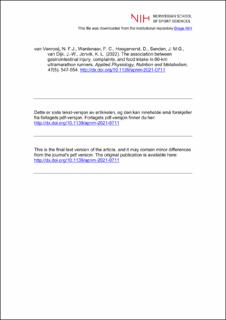| dc.contributor.author | van Venrooij, Niek F.J. | |
| dc.contributor.author | Wardenaar, Floris C. | |
| dc.contributor.author | Hoogervorst, Daan | |
| dc.contributor.author | Senden, Joan M.G. | |
| dc.contributor.author | van Dijk, Jan-Willem | |
| dc.contributor.author | Jonvik, Kristin Lundanes | |
| dc.date.accessioned | 2022-12-06T10:10:23Z | |
| dc.date.available | 2022-12-06T10:10:23Z | |
| dc.date.created | 2022-10-17T15:52:09Z | |
| dc.date.issued | 2022 | |
| dc.identifier.citation | Applied Physiology, Nutrition and Metabolism. 2022, 47(5), 547-554. | en_US |
| dc.identifier.issn | 1715-5312 | |
| dc.identifier.uri | https://hdl.handle.net/11250/3036057 | |
| dc.description | I Brage finner du siste tekst-versjon av artikkelen, og den kan inneholde ubetydelige forskjeller fra forlagets pdf-versjon. Forlagets pdf-versjon finner du på www.cdnsciencepub.com / In Brage you'll find the final text version of the article, and it may contain insignificant differences from the journal's pdf version. The original publication is available at www.cdnsciencepub.com | en_US |
| dc.description.abstract | We aimed to assess the association between gastrointestinal (GI) injury, complaints, and food intake in 60-km ultramarathon runners. Thirty-three ultramarathon runners provided pre- and post-race blood samples for assessment of GI injury by intestinal fatty-acid binding protein (I-FABP), and inflammatory response by interleukin (IL)-6, IL-8, tumour necrosis factor alpha (TNF-α), and C-reactive protein (CRP). GI complaints and nutritional intake were reported by a post-race questionnaire. GI complaints were reported by 73% of the runners, of which 20% reported 1 or 2 severe complaints. IL-6, IL8, TNF-α, and CRP increased significantly from pre- to post-race (P < 0.001 for all biomarkers), while I-FABP did not (1375 [IQR: 1264–2073] to 1726 [IQR: 985–3287] pg/mL; P = 0.330). The ‘GI complaints score’, as the integral of the number and severity of GI complaints, did not correlate with ΔI-FABP (rs: –0.050, P = 0.790) or energy intake (rs: 0.211, P = 0.260). However, there was a significant negative correlation between energy intake and ΔI-FABP (rs: –0.388, P = 0.031). In conclusion, GI complaints were neither associated with food intake nor GI injury as assessed by plasma I-FABP response. Energy intake, however, was inversely related to the I-FABP response to exercise. This finding suggests that substantial energy intakes during exercise may prevent exercise-induced GI injury as assessed by the I-FABP response.
Novelty:
No association between gastrointestinal complaints and gastrointestinal injury (I-FABP response) or food intake was present.
There was an inverse correlation between energy intake and plasma I-FABP response, suggesting that higher energy intakes may prevent gastrointestinal injury as assessed by the I-FABP response. | en_US |
| dc.language.iso | eng | en_US |
| dc.subject | GI distress | en_US |
| dc.subject | GI damage | en_US |
| dc.subject | I-FABP | en_US |
| dc.subject | nutritional intake | en_US |
| dc.subject | running | en_US |
| dc.subject | exercise-induced GI symptoms | en_US |
| dc.title | The association between gastrointestinal injury, complaints, and food intake in 60-km ultramarathon runners | en_US |
| dc.title.alternative | The association between gastrointestinal injury, complaints, and food intake in 60-km ultramarathon runners | en_US |
| dc.type | Peer reviewed | en_US |
| dc.type | Journal article | en_US |
| dc.description.version | acceptedVersion | en_US |
| dc.source.pagenumber | 547-554 | en_US |
| dc.source.volume | 47 | en_US |
| dc.source.journal | Applied Physiology, Nutrition and Metabolism | en_US |
| dc.source.issue | 5 | en_US |
| dc.identifier.doi | 10.1139/apnm-2021-0711 | |
| dc.identifier.cristin | 2062143 | |
| dc.description.localcode | Institutt for fysisk prestasjonsevne / Department of Physical Performance | en_US |
| cristin.ispublished | true | |
| cristin.fulltext | postprint | |
| cristin.qualitycode | 1 | |
